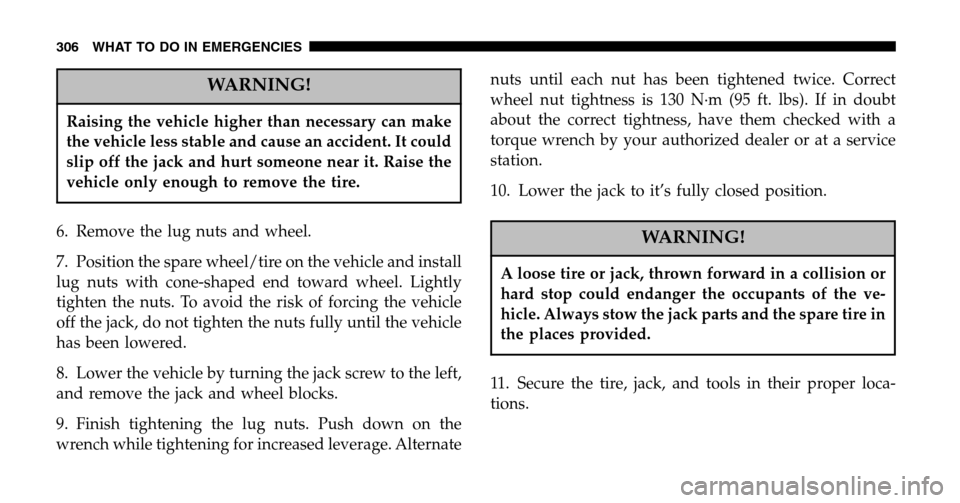Page 179 of 424

Also, the light will come on when the parking brake is
applied with the ignition switch in the ON position.
NOTE: This light shows only that the parking brake is
applied. It does not show the degree of brake application.
If the parking brake is off and the light remains on, have
the brake system inspected as soon as possible.
19. Full Time Indicator Light — If Equipped This light alerts the driver that the vehicle is in
the FULL TIME four–wheel drive mode, and
employs the inter-axle differential which al-
lows the front and rear wheels to rotate at
different speeds. (See page 234 for more information.)
20. Sentry Key/Security Alarm Indicator Light — If
Equipped
Refer to “Sentry Key Immobilizer System” or “Vehicle
Security Alarm” in Section 2 of this manual for more
information. 21. Fuel Gage
When the ignition key is in the ON position, the pointer
will show the level of fuel remaining in the fuel tank. A
small arrow indicates the side of the vehicle where the
filler cap (gas cap) is located.
22. Low Fuel Warning Light
When the fuel level reaches approximately 2.3 U.S.
Gallons (8.7 Liters) this light will come on and
remain on until fuel is added. The “Low Fuel
Warning Light” may turn on and off again, especially
during and after hard braking, accelerations, or turns.
This occurs due to the shifting of the fuel in the tank.
Also, a single chime will sound.
23. Airbag Warning Light This indicator lights and remains lit for 6 to 8
seconds when the ignition is first turned on. If the
UNDERSTANDING YOUR INSTRUMENT PANEL 179
4
Page 222 of 424
Should your vehicle run out of fuel, the fuel system must
be re-primed in order to start the engine. Factors such as
temperature, which affects the viscosity of the fuel, how
long the vehicle has been sitting and other factors will
influence how quickly the engine starts.
Re-Priming the Diesel Fuel System
The following procedure must be followed after com-
pletely running out of fuel.
1. Add a minimum of 2 gallons (7.57L) of diesel fuel to
the fuel tank.
2. Open the hood.
3. Depress the fuel-water separator knob 20 consecutive
times. 4. Turn the ignition to START and crank the engine a
maximum of 10 seconds. If the engine does not start,
repeat Step 3.
NOTE:
The engine will typically start within 10 sec-
onds; the engine will idle then stall, purging air from the
fuel lines and filter.
Hand Prime Pump
222 STARTING AND OPERATING
Page 223 of 424

5. Depress the fuel-water separator knob 20 consecutive
times.
6. Turn the ignition to START and crank the engine a
maximum of 10 seconds. The engine should start and
remain running.
NOTE: If the engine does not start, repeat the cycle as
many times as necessary.
ENGINE BLOCK HEATER — IF EQUIPPED
The engine block heater warms engine coolant and
permits quicker starts in cold weather. Connect the cord
to a standard 110-115 volt AC electrical outlet with a
grounded, three wire extension cord.
•The engine block heater cord is found under the hood
clipped to the heater line on the left side of the engine
(3.7L Engines).
•The engine block heater cord is strapped to the engine
oil dipstick tube on the left side of the engine (2.8L
Diesel Engines).
WARNING!
Remember to disconnect the cord before driving.
Damage to the 110-115 volt AC electrical cord could
cause electrocution.
Use the heater when temperatures below 0°F (-18°C) are
expected to last for several days.
STARTING AND OPERATING 223
5
Page 228 of 424
Gear Ranges
P (Park)
Supplements the parking brake by locking the transmis-
sion. The engine can be started in this range. Never use P
(Park) while the vehicle is in motion. Apply the parking
brake when leaving the vehicle in this range. Always
place the gear selector in the P (Park) position first, and
then apply the parking brake.
WARNING!
Unintended movement of a vehicle could injure
those in and near the vehicle. As with all vehicles,
you should never exit a vehicle while the engine is
running. Before exiting a vehicle, you should always
shift the vehicle into P (Park), remove the key from
the ignition, and apply the parking brake. Once the
key is removed from the ignition, the transmission
shift lever is locked in the P (Park) position, securing
the vehicle against unwanted movement. Further-
more, you should never leave children unattended
inside a vehicle.
228 STARTING AND OPERATING
Page 238 of 424

NOTE:Shifting into or out of 4L is possible with the
vehicle completely stopped, however difficulty may oc-
cur due to the mating clutch teeth not being properly
aligned. Several attempts may be required for clutch
teeth alignment and shift completion to occur. The pre-
ferred method is with the vehicle rolling 2 to 3 mph (3 to
5 km/h). Avoid attempting to engage or disengage 4L
with the vehicle moving faster than 2 to 3 mph (3 to 5
km/h).
Selec-Trac \bOperating Information/Precautions —
If Equipped
The Selec-Trac �transfer case provides 5 mode positions -
normal 2-wheel drive mode, part-time 4-wheel drive
high range, full-time 4-wheel drive high range, neutral,
and 4-wheel drive low range.
This transfer case is equipped with an inter-axle differ-
ential which allows driving the vehicle in the 4 FULL
TIME position at all times on any given road surface including dry hard surfaced roads. The 4 FULL TIME
mode allows the front and rear wheels to rotate at
different speeds which eliminates driveline binding and
component wear that is normally associated with driving
the vehicle in the 4 PART TIME position on dry hard
surfaced roads. This feature provides the safety, security,
and convenience of operating in 4–wheel drive at all
times regardless of road conditions.
When additional traction is required the 4 PART TIME
and 4LO positions can be used to lock the front and rear
driveshafts together through the transfer case inter-axle
differential and force the front and rear driveshafts to
rotate at the same speed. This is accomplished by simply
moving the shift lever to these positions. The 4 PART
TIME and 4LO positions are intended for loose, slippery
road surfaces only. Driving in the 4 PART TIME and 4LO
positions on dry hard surfaced roads may cause in-
creased tire wear and damage to driveline components.
238 STARTING AND OPERATING
Page 289 of 424

WARNING!
Improper towing can lead to an injury accident.
Follow these guidelines to make your trailer towing
as safe as possible:
Make certain that the load is secured in the trailer
and will not shift during travel. When trailering
cargo that is not fully secured, dynamic load shifts
can occur that may be difficult for the driver to
control. You could lose control of your vehicle and
have an accident.
•When hauling cargo or towing a trailer, do not over-
load your vehicle or trailer. Overloading can cause a
loss of control, poor performance or damage to brakes,
axle, engine, transmission, steering, suspension, chas-
sis structure or tires.
•Safety chains must always be used between your
vehicle and trailer. Always connect the chains to the
frame or hook retainers of the vehicle hitch. Cross the
chains under the trailer tongue and allow enough
slack for turning corners.
•Vehicles with trailers should not be parked on a grade.
When parking, apply the parking brake on the tow
vehicle. Put the tow vehicle automatic transmission in
P for Park. With a manual transmission, shift the
transmission into reverse. And with four-wheel-drive
vehicles, make sure the transfer case is not in neutral.
Always, block or �chock�the trailer wheels.
•GCWR must not be exceeded.
•Total weight must be distributed between the tow
vehicle and the trailer such that the following four
ratings are not exceeded:
1. GVWR
STARTING AND OPERATING 289
5
Page 306 of 424

WARNING!
Raising the vehicle higher than necessary can make
the vehicle less stable and cause an accident. It could
slip off the jack and hurt someone near it. Raise the
vehicle only enough to remove the tire.
6. Remove the lug nuts and wheel.
7. Position the spare wheel/tire on the vehicle and install
lug nuts with cone-shaped end toward wheel. Lightly
tighten the nuts. To avoid the risk of forcing the vehicle
off the jack, do not tighten the nuts fully until the vehicle
has been lowered.
8. Lower the vehicle by turning the jack screw to the left,
and remove the jack and wheel blocks.
9. Finish tightening the lug nuts. Push down on the
wrench while tightening for increased leverage. Alternate nuts until each nut has been tightened twice. Correct
wheel nut tightness is 130 N·m (95 ft. lbs). If in doubt
about the correct tightness, have them checked with a
torque wrench by your authorized dealer or at a service
station.
10. Lower the jack to it’s fully closed position.WARNING!
A loose tire or jack, thrown forward in a collision or
hard stop could endanger the occupants of the ve-
hicle. Always stow the jack parts and the spare tire in
the places provided.
11. Secure the tire, jack, and tools in their proper loca-
tions.
306 WHAT TO DO IN EMERGENCIES
Page 308 of 424

NOTE:To start the vehicle following connection of a
booster battery, the Security Alarm System must first be
disabled by cycling a front door key cylinder or by using
the keyless entry transmitter.
WARNING!
Jump starting can be dangerous. To avoid personal
injury or damage to electrical components in vehicle,
observe the following warnings:
•Battery fluid is a corrosive acid solution and can burn
or even blind you. Don’t allow battery fluid to contact
your eyes, skin, or clothing. Don’t lean over a battery
when attaching clamps. If acid splashes in eyes or on
skin, flush the area immediately with large amounts of
water.
•Do not use a booster battery or any other booster
source that has a greater than 12–volt system, i.e., do
not use a 24–volt power source.
•Never attempt to jump start a discharged battery that
is frozen, because it could rupture or explode during
jump starting.
•Be sure your vehicle is not touching the jump start
vehicle.
•Observe all Battery Warnings in Section 7 of this
manual, while jump starting your vehicle.
308 WHAT TO DO IN EMERGENCIES